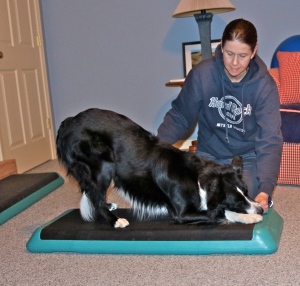“Lift with your legs, not your back! Tighten those core muscles!”
Think about when you have worked out with a personal trainer or if you have ever taken a kickboxing, pilates, yoga or cycle class. What is it that the instructor is frequently “barking” at you about? That’s right, form. They often want you to slow down your movements and focus on your form so that you get the most out of your workout in the safest way. The same goes for when we exercise our dogs.
Paying attention to your dog’s form during exercise is one of the most important aspects of canine conditioning. We watch body positions in order to avoid putting stress on the neck, spine, shoulders and/or hips. In general, we watch the dog for:
- Natural head position and neck relaxed
- Neutral back, no arching or roaching (depending on the breed- for example, we would not expect a greyhound to have a flat back)
- Foot position
We also watch our dog’s form so that we are engaging the proper muscles, getting the most out of the exercise, and safely executing the position.
For example, if I want to engage my dog’s core, hind limbs, and shoulder rotation when I am having my dog lie down, then I want to have them fold into the position with their feet planted in one spot. If they sit first and then walk their front legs forward until they are in a down position they not only put stress on their shoulders but they do not engage the muscles in the rear and core. (For more on the folding down, click here)

So remember, it’s not just about exercising your dog, it’s about getting the most out of the WAY you do it!






